Photography by Alan Poelman
Norman Jordan still remembers the day he saw the last horse disappear. He was 10 years old in 1977 when he witnessed some men haul away four Ojibwe ponies from the Lac La Croix First Nation, part of Treaty 3 territory in northwestern Ontario. Slated to be destroyed by the Canadian government, those four mares were all that remained of these horses, kindred spirits that had always lived with and around Jordan’s people in this dense swath of boreal forest. “I remember feeling very sad; I felt tormented,” says the former chief. “I was sitting at a big picture window, watching them. My heart was sinking, because I wondered if we’d ever see them again.”
You may unsubscribe from any of our newsletters at any time.
Staring out at the sparkling waves of the lake that gave his First Nation its colonial name, Jordan recalls just how integral these semi-feral horses were to his people, describing how they would stomp out trails between the trees that sheltered the reserve. They liked human contact, helping people in times of need, especially during winter. Numbering a few thousand around the year 1900, they trotted back and forth across the Ontario-Minnesota border, paying no heed to the white man carving up their domain. A veritable workhorse, the Lac La Croix Indian pony, as the Ojibwe pony is also called, lived in a reciprocal relationship with Ojibwe First Nations in the region. “They were so much a part of us,” says Jordan.
He had every reason to worry that day more than 40 years ago. Settlers on both sides of the border had nearly brought the Ojibwe companion to its demise. But those four mares escaped their execution — friends whisked them away to safety on another reserve on the American side of the lake. Still, the attempted extinction of the Ojibwe horse reads very much like the broader genocide brought down on Indigenous peoples. Now, as the number of Canada’s only Indigenous-bred horse is slowly growing, Ojibwe people are discovering a way to reclaim a part of their heritage, finding in the horse a spiritual connection to their past and a way forward in healing intergenerational trauma.

Once upon a time, before the last Ice Age, horses galloped across the North American landscape. But when the Laurentide Ice Sheet pressed its way across the continent, before retreating some 11,000 years ago, the horses ran away, trying to keep a pace ahead of that cold front. Entire herds slipped across the Bering land bridge in the far northwest, where Alaska met Siberia, and the horse vanished from North America. It wouldn’t come back until around the year 1500, when European explorers, settlers, invaders, colonizers — however you see them — brought horses on their ships.
Or so the history goes.
Some say otherwise: that horses survived the Ice Age as dispersed herds in pockets of North America and have been with some Indigenous people since time immemorial. The Ojibwe horse is believed to be one of the survivors, roaming the forest in both Canada and the United States, eating what deer eat: twigs, tall grasses, shrubs, even the bark off the trees.
“The history surrounding these ponies and their relationship with the original peoples of North America supports the claim that they were always here,” says Yvette Collin. She spent years meeting with scientists and Indigenous experts across the United States as part of her PhD thesis on the American horse. She also runs the Sacred Way Sanctuary, an Alabama ranch that is home to a few different Indigenous breeds, including Ojibwe ponies.
The proof of the horse’s pre-colonial existence includes both oral histories and petroglyphs from before European contact that show horses. Besides, observes Collin, who is Lakota, it’s ridiculous to think that some tribes could have developed such a strong bond with the horse faster than anyone else in the world. People in Asia, for example, are known horse people and they developed these skills and connection over thousands of years. “It doesn’t add up,” says Collin.
It’s also curious how the Ojibwe horse could have adapted to such a specific environment in a relatively short amount of time. Adaptation usually takes much longer. But here was a pony that was perfectly suited to its environment: a nose flap to hinder cold air from entering its lungs, rock-hard hooves for running over the Canadian Shield, fuzzy ears to protect it from insects. Even its size — less than 14 hands tall — is tailored to the terrain. Compact and powerful, the pony-sized horse could push through its dense forest habitat.
In the early 1900s, the horses were at all the reserves in the region, not just Lac La Croix. People would fetch a horse to haul wood and pull ice blocks from the lakes. The ponies were also used instead of dogs on traplines to bring home the harvest. In exchange, the animals received food during the barren cold season; in spring and summer, they were given a break from human chores and roamed free. The people of Lac La Croix would herd the ponies over lake ice in spring to an island they fittingly called Pony Island where the animals could feed and breed and foal.
But a series of events in Canada and the United States in the early 20th century devastated the Ojibwe companion. This added yet another level of violence to the forced displacement of Indigenous peoples to reserves, many in remote or inaccessible parts of the country. Stateside, some of the last horses were killed off in the 1940s after missionaries at a reservation in Minnesota decided it was inappropriate for children to witness horses breed.
More on Broadview: Do exotic pets belong in our homes?
In Ontario, the reasons for the horse’s downfall are more manifold and murky. Elders have passed on stories of Indigenous people being forcibly removed to make way for the establishment of Quetico Provincial Park in 1913. Some speculate that this affected the horse populations as well.
Elders also talk about outsiders taking away herds, turning them into glue or food. Some believe removing the horses was a way of limiting Indigenous movement, which in turn freed up land for farmers and industry. The horses were especially vulnerable when they wandered off the reserve; their Indigenous caretakers weren’t allowed to leave without a permit.
Technology played a part in the horses’ decline, too. By the 1960s, people started buying snowmobiles for use on the traplines and to pull supplies; horsepower was no longer required. It was cheaper to have a snowmobile, which didn’t eat while it was sitting idle. While the horses were capable of surviving on their own, they fared better under the protection of the Ojibwe people.
Heather O’Connor, a writer who has been researching the history of the horse in Ontario, sifting through reams of archival footage and documents and interviewing elders, says another possible negative impact was a newly constructed dam flooding the area. This could have cut off food sources, even drowning some horses. “We took away their habitat,” says O’Connor, who is writing three children’s books about the Ojibwe horse.
The final blow nearly came in the 1970s when the Canadian government caught wind of the last four horses hoofing around Lac La Croix. Having no owner — private ownership of an animal was antithetical to Ojibwe beliefs — the health department considered them nuisance animals that needed to be eliminated. But before the authorities could execute their order, Fred Isham, an Ojibwe man living in Nett Lake, a reservation in Minnesota, intervened.
When Isham heard that the horses were in danger, he decided to rescue them. He was among the men Jordan watched take the horses on that winter’s day back in 1977. “He knew they were special horses,” says Jordan.
Out of harm’s way in Minnesota, they were resettled to freely roam on the ranch of a Finnish farmer who agreed they had to be spared slaughter. But without a young stallion — the last one was ambushed in Ontario by a hunter who mistook it for a moose — the future of the Ojibwe horse was far from certain.
Still, they were the last mares standing.
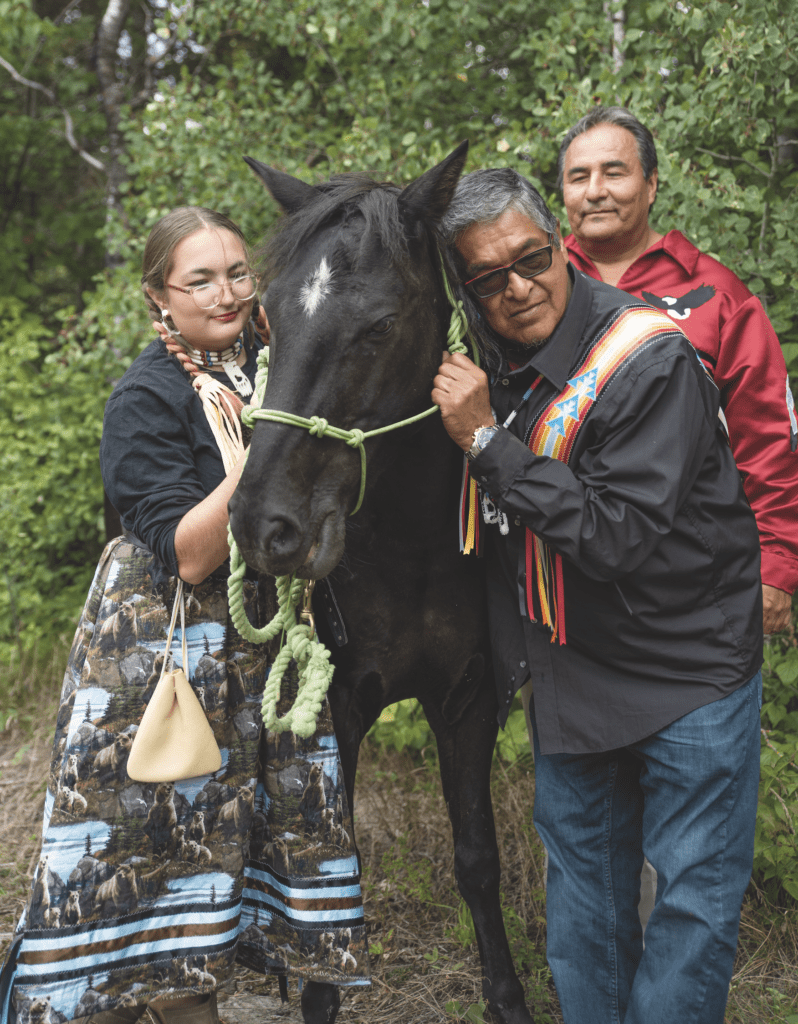
Flanking Highway 11 in Treaty 3 territory, thick stands of black spruce dance in the wind. Their rhythm and shape change depending on whether the gusts are from the boreal forest to the north, the Prairies to the west or the shores of Lake Superior to the south. Sometimes the swaying treetops morph into eagles, deer and ravens. With a bit of imagination, they conjure Ojibwe horses, their long, flowing manes drawn by breeze-bent branches.
Not long ago, there was no need to imagine horses along this stretch of highway; they were so plentiful that the Seine River First Nation, a reserve just off it, was referred to as Horsecollar Junction. “They roamed like deer,” says Darcy Whitecrow, who runs Grey Raven Ranch in Seine River with Kimberlee Campbell. The couple lives in a blue house on a hill. In the paddock beside their home, two curious, black Ojibwe horses greet visitors. Step inside the house, though, and the dogs take over: three chihuahuas, “the Screaming Mimis,” as Campbell calls them, and Grizzly, a calm, black malamute-German shepherd mix nearly the size of the colt outside.
Seated at the table in their kitchen, Campbell and Whitecrow talk about the creation of Grey Raven Ranch. His family name is Grey Raven, but “when the government wanted to give us a name, they misinterpreted,” says the former social worker, pouring cups of strong coffee. The actual family name was rescued with the start of the ranch, which opened in 2014 in an effort to help save the Ojibwe horse along with local Indigenous knowledge and culture.
“When there were only four of these horses left, the choices were breed them with another horse or let them die out,” explains Campbell. To make sure the Standing Four would not become the Last Four, the saviours brought in a Spanish mustang stallion. Eventually the mares bore offspring, and the number of Ojibwe horses started growing in Minnesota.
It wasn’t until the 1990s, however, that Rare Breeds Canada, an organization now called Heritage Livestock Canada that promotes the preservation of traditional animals, got involved and helped repatriate some of the ponies from the United States. A few breeders have since steadfastly worked to bring their number up to 175 today.
To track the parentage of the ponies, all owners of Ojibwe horses are encouraged to register their animals with the Ojibwe Horse Society, a volunteer non-profit that keeps tabs on the breed’s history and bloodlines. The parentage testing — like a paternity test but for horses — is done by having either hair, with the follicle attached, or blood samples taken and sent for genetic testing.
Gus Cothran, a renowned equine geneticist in Texas, did some of the early mapping of the Ojibwe pony. He confirms that it is genetically distinct. “The Lac La Croix [horse],” says Cothran, “doesn’t show any relationship to other domestic breeds.”
But because the Standing Four were so small in number, there are some challenges to ensuring the healthy survival of the breed. Cothran describes the population as a genetic bottleneck. “In a closed, small population, you’re going to lose diversity over time,” he says. “Inbreeding can be bad because it means that the chances of a defective gene in one individual being paired with the same defective gene in another individual go up.”
Finding pairs that aren’t too closely related is one of Helen Wilson’s biggest challenges to increasing the horse’s population. Wilson, whose ranch is located near Bon Accord, Alta., north of Edmonton, has been breeding the kind, smart, fast-learning horse since 2006. She says the process can be slow and onerous but wholeheartedly merits the effort. “It means a lot to me that this horse is indigenous, because my grandchildren are Indigenous,” says Wilson, who, like many of the current registered breeders, is white. “The horses were part of Indigenous peoples’ life, part of their culture, part of their family. And along with everything else that was taken from them, the ponies were also taken.”
While breeders are doing their part to boost the population, it is Grey Raven Ranch that can be credited for the reintroduction of the Ojibwe horse to reserves in Canada. Since its start, the ranch has been running a program in which Indigenous kids and youth learn about the history of their ancestors’ spirit animal and the traditions that went along with that coexistence. Supported by a Treaty 3 resolution,

some government money for Indigenous projects and a chunk of personal savings, the program also aims to reconnect children with nature.
Whitecrow gets busy frying walleye pulled from a lake on the reserve the day before. His specialty is to dust the fillets in crushed cornflakes for a golden crunch and serve them with sliced bread and tartar sauce. While Whitecrow is cooking, Campbell explains their program.
The kids attend for free and come from Seine River, other reserves and from as far away as Fort Frances and Thunder Bay, Ont., to learn to care for, lead and ride the horses. This involves gaining the horses’ trust, something that requires trust in oneself. By extension, the kids also learn respect, patience and sensitivity as they build a relationship with their new four-legged friends. “The idea is to fix a generation before it’s broken,” says Whitecrow, explaining that the boost in self-confidence and focus the youth get at the ranch helps them stay in school and out of trouble.
Many of the youth at Seine River, which has a population of 260 people, feel like they have little control over their immediate world. The high school drop-out rate is high, and the job prospects and economic opportunities on the reserve are limited. “The colonial system is destructive,” says Whitecrow, who raised four children as a single parent for many years until he met Campbell. Add to that the challenges that crop up when youth try to figure out their place in society and how to bridge the gap between the traditional values of their people with those of the settler-dominated world.
The traumatic legacy of Sir John A. Macdonald’s belief that “Indian children should be withdrawn as much as possible from the parental influence” and placed in residential schools is still felt today. Whitecrow explains that Ojibwe were punished for speaking their own language, practising their beliefs, and singing and dancing songs that were passed down through generations. This made them feel ashamed of who they were. No wonder there’s a general lack of hope for the future among young people today, not only in Seine River but also on many other reserves.
“I work on a lot of different reserves, mostly on the U.S. side,” says Campbell, a semi-retired Harvard University professor and Indigenous language educator. “What you notice is the lack of agency.… And so you have a huge problem with suicide, for example. You have the problem of drug and alcohol abuse.”
She leans back toward the living room. On one wall, a mural depicts a woman sitting on a turtle that is surrounded by a lake, representing Turtle Island. On a patch of earth is a muskrat — Whitecrow’s clan — its smooth body looking like it’s about to leap into the room.
“The thing that was so priceless to me,” she says, “was to show kids, even a few kids in a limited way: you can effect change in the world. You can do something, even if it’s a small something.”
“Even if it’s just one kid,” Whitecrow adds.
“Even if it’s just one kid,” agrees Campbell. “I’ll take as many kids as we can get, but obviously those 20 kids saw something happen.” She is referring to the days when the young ranch volunteers helped put up fencing back in 2014. They could see concrete results.
“We all look for a legacy,” says Whitecrow. “These kids don’t even know the full extent of what they’re doing right now….They’re bringing an endangered species of their ancestors back into existence.” He and Campbell hope their legacy will be to inspire positive change. They dream of seeing a youth program with horses up and running on every reserve in Treaty 3 territory.
A case in point is Tashie Broadbent. One morning last May, the 16-year-old arrives at Grey Raven Ranch, ready to spend some time with Naabesim (“Stud Colt” in Ojibwe) and Babaaminizhikawaad (“He Chases Them Around”), or Sim and Chase for short.
Broadbent walks into the paddock beside the horses’ lakeside pasture and strokes Chase’s neck. She pulls out a brush and gets rid of old thistles, dirt and dry grass, before leading him around and finally getting up on his back. “Tashie is a natural horse person,” says Campbell. “She’s only been here a few times, and she’s already communing with the horse.”
Broadbent lives on the Manitou Rapids 11 reserve, west of Fort Frances, Ont., but she grew up in southern Ontario, far from her roots. “I’ve just recently started learning about my culture,” she says. “My dad was part of the Sixties Scoop.” Adopted by a settler family, he was cut off from his Ojibwe family, and she lost out as a result. Relating to this horse is a way for her to connect with her past — and forge a future as an Ojibwe woman.
She jumps off Chase, gives him a carrot and rubs his neck. “I tend to like people to tell me what to do more than taking initiative for myself. Here with the horses, I have to be the leader; I have to show them what to do. I think that helps a lot.” She says the horses have even inspired her to lead programs for youth in her community.
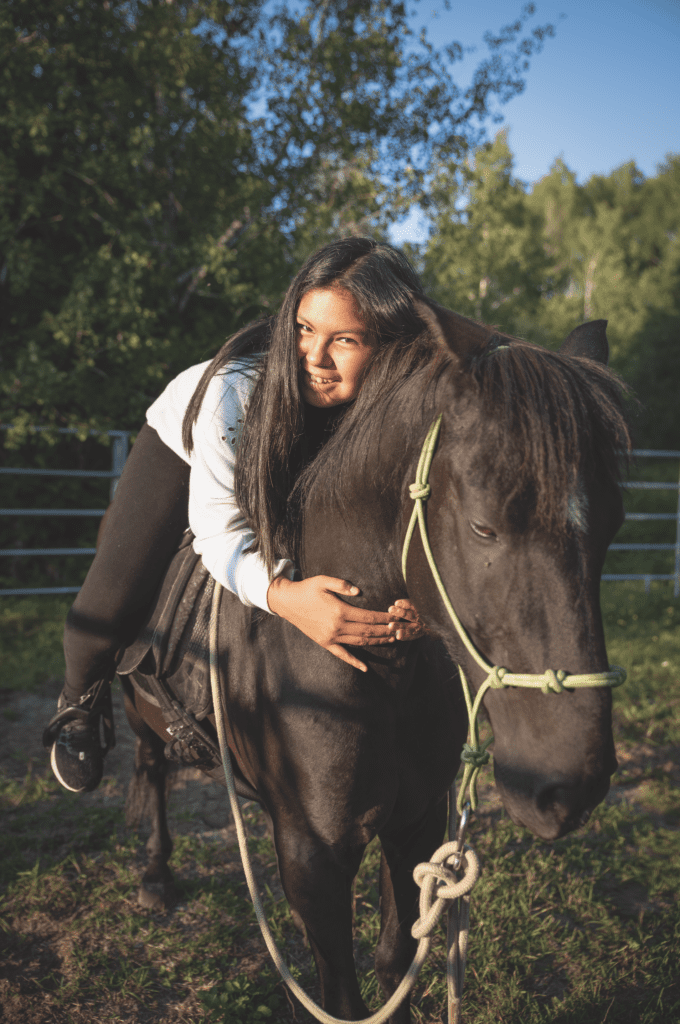
Ten-year-old Norman Jordan could never have guessed that the horse his ancestors had lived with would ever be back at his Lac La Croix First Nation. But in the winter of 2017 — almost 40 years to the day the horses left — he was standing outside under the frost-fall of night, shivering from the cold and excited anticipation. His attention was focused on the road.
Around 1 a.m., a truck pulling a trailer rounded the last curve into the reserve, its headlights flooding the same birch and aspen and poplar trees that once sheltered the free-range horses. The truck stopped, and the driver got out to open the back of the trailer. And just like that, a small herd of Ojibwe horses emerged — the first to set foot on the reserve since those last four mares were spirited across the border.
Now 52, Jordan works with his wife, Skuya Fasthorse, as an official horse caretaker for the First Nation, tending to a herd of seven. Fasthorse, who has always had a connection with horses and has worked as a veterinary technician, says that horses are conduits for healing. “The horses really helped me,” she says, recalling a time when the animals were the only beings that she felt she could trust with her trauma after surviving a sexual assault. “I found a lot of healing with being able to talk to the horse and let myself trust again.”
That trust is something she hopes to be able to help build in youth as well as adults at Lac La Croix, taking cues from Grey Raven Ranch, which is just two hours away. The reserve (its Ojibwe name is Zhingwaako Za’Iganing, meaning “Lake of Large Red Pines”) has a high unemployment rate, almost four times that of the province’s. They’re hoping the horses will help rebuild a strong sense of self — and pride — in being Ojibwe.
Taking a step back to traditional ways with the horse might lead to taking a step forward for the community. Jordan says the goal is to start programs once he and Fasthorse have been able to teach the ponies to be calm under any circumstance, just like they were back in the days when they roamed free and willingly formed a partnership with people.
“When they left, I had that deep grief, that sense of loss because they were so much a part of our culture. They helped the community by being here in so many ways,” says Jordan as two children on bikes stop by to pet the ponies.
It’s clear that saving the Ojibwe horse represents an act of relationship building — between horse and human, between nature and heritage, between past and present. The horse may have changed on a genetic level since it was rescued and crossbred with that Spanish mustang, but it has also evolved into a figurative mode of transportation for a culture. “When they returned, it was an overwhelming feeling,” says Jordan. “Who would have thought they’d be back?”
He turns around, picks up a bucket with equine treats and enters the paddock. Fasthorse is already inside. The horses come closer, their noses stretched forward in anticipation. They gather in a circle around their caretakers.
This story first appeared in Broadview’s November 2019 issue with the title “Pony rescue.”
Broadview is an award-winning progressive Christian magazine, featuring stories about spirituality, justice and ethical living. For more of our content, subscribe to the magazine today.



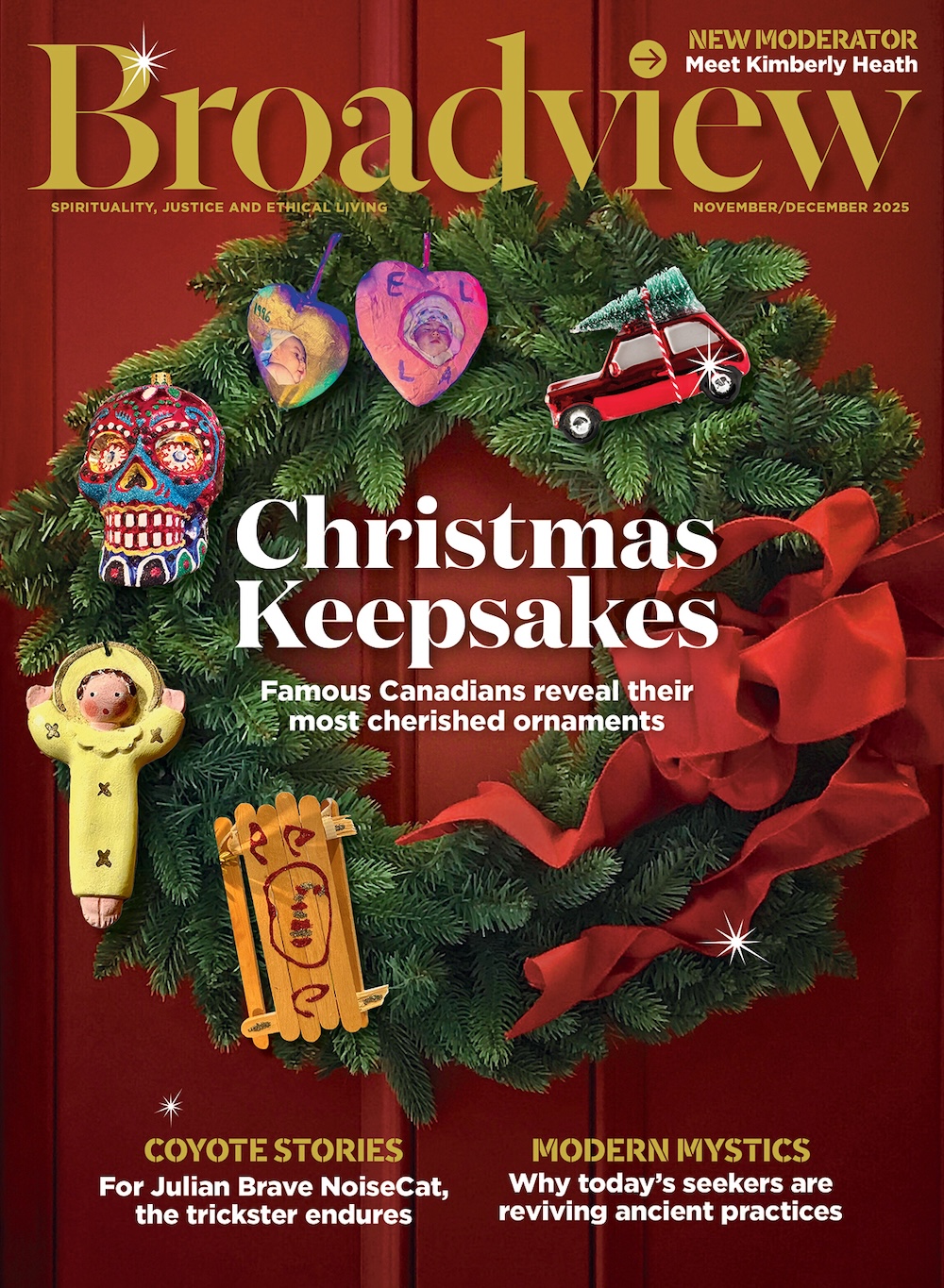
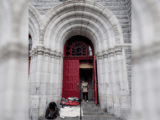
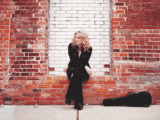





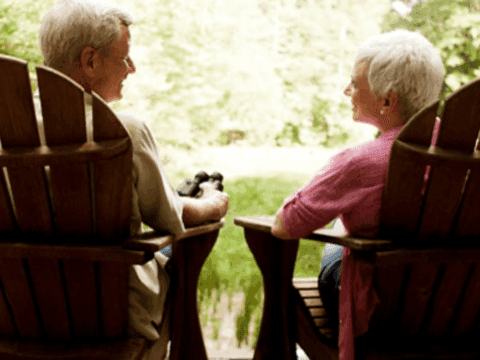

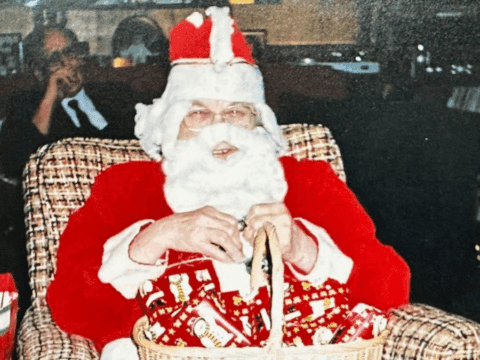

I loved reading this article. Some articles are so full of misinformation out there. I love knowing that these ponies are finally having a chance again. They’re so incredible, so strong, so lovable, intelligent, gentle and loving. I am glad I met the Lac La Croix Pony, and am glad to have raised one even though she is a cross. She has taught me a lot over the last 14 years.
this is wonderful, I wonder if Ojibwa horse breeders would be interested in a Nez Pierce outcross. The Nez Pierce horses are also indigenous, although I don’t know if they are a pure land race any more. I have been working to preserve the Alaskan Village Dog, so am very interested in this project.
Well may GREAT SPIRIT continue to bless you
Can these horses be purchased anywhere? I am in such a need for the spirit healing these wonderful animals have to offer. Does the horse have a special breed to look for?
Hi Judi,
The Ojibwe Horse Society should be able to let you know which breeders registered with them sell horses. You can find the Society’s website here: http://ojibwehorse.ca
This story touches my soul. I am a Wampanoag woman from Massachusetts.
This story is one that touches the soul. It teaches humans, our Indigenous cultures that once were one with our four legged ones how to “be” again. The bond that exists is in the DNA. Now scholars of thought will negate my claim but there is a SACRED CONNECTION that can’t be denied, we know this. I loved this story. The connection between the people and the horses has been brought back and will thrive again, this is OUR TRUTH…..
It brings tears to my eyes and breaks my heart over the destruction of the INDIGENOUS PEOPLE and their way of being. THIS IS SACRED. I DON’T EXPECT THE WRITER TO UNDERSTAND THIS CONCEPT…..you have not been chosen by CREATOR TO BE HERE, TO COEXIST WITH ALL OTHER CREATURES OF CREATION……
Such beautiful holy work! G-d bless you for saving these sacred horses! Kol Hakavod for knowing how!
Thank the Spirit – that – Moves- Through – All – Things for helping the People to save their precious ponies. The spiritual bond between man and horse is a sacred thing that should never perish.
What wonderful work you all are doing ! God Bless these dear horses in your care . Long may they reign !
We’re very excited to be involved with this great group of dedicated breeders and caregivers. We hope to see our first LLCIP (Ojibway) foal born in 2020, and look forward to growing our herd of ponies.
Beautiful horses and beautiful people❤❤❤
BEAUTIFUL STORY……I LOVE HORSES AND KNOW HOW THEY LIFT THE HUMAN SPIRIT……I`M SO HAPPY THIS IS HAPPENING FOR THEIR CULTURE AND FOR THE HORSES
Absolutely Awesome so good to know they are coming back this is as it should be. It was so Very wrong of them to have ever left in the first place.
I was so happy to see the ponies coming back! I love all horses but these ponies are special and I hope they keep growing into a larger known group. God bless them!
How wonderful, the thought of the ponies roaming freely amongst the people. To have them return in this fashion, what a great save & a great history.
???✌️Spirit of the Horse
This made me cry…sadness and happiness, all at once…
I am so glad to see this story, so glad to see the indigenous peoples taking back their culture in yet another way, to help their youth feel connected.
Thank you for your beautiful story. I live in Idaho, the state horse is the Appalousa, a breed probably not as old as your Ojibway horse, but very important to the Nez Perce tribe.
That’s a beautiful story Miigwetch.
A very, very special story. I am not Canadian, or have any links with the first Nations. But I felt a strong connection with, what I call the Earth people. In the seventies I came to Canada, I had read the story about Gray Owl. He was English, but lived with the Ojibwa, the government set up an area in Saskatchewan where he started a beaver colony to help stop them from extinction, trapping. I stayed with his daughter Agnes, I also visited the Cree at Lake Mistassini, Quebec. Take care. Stewart